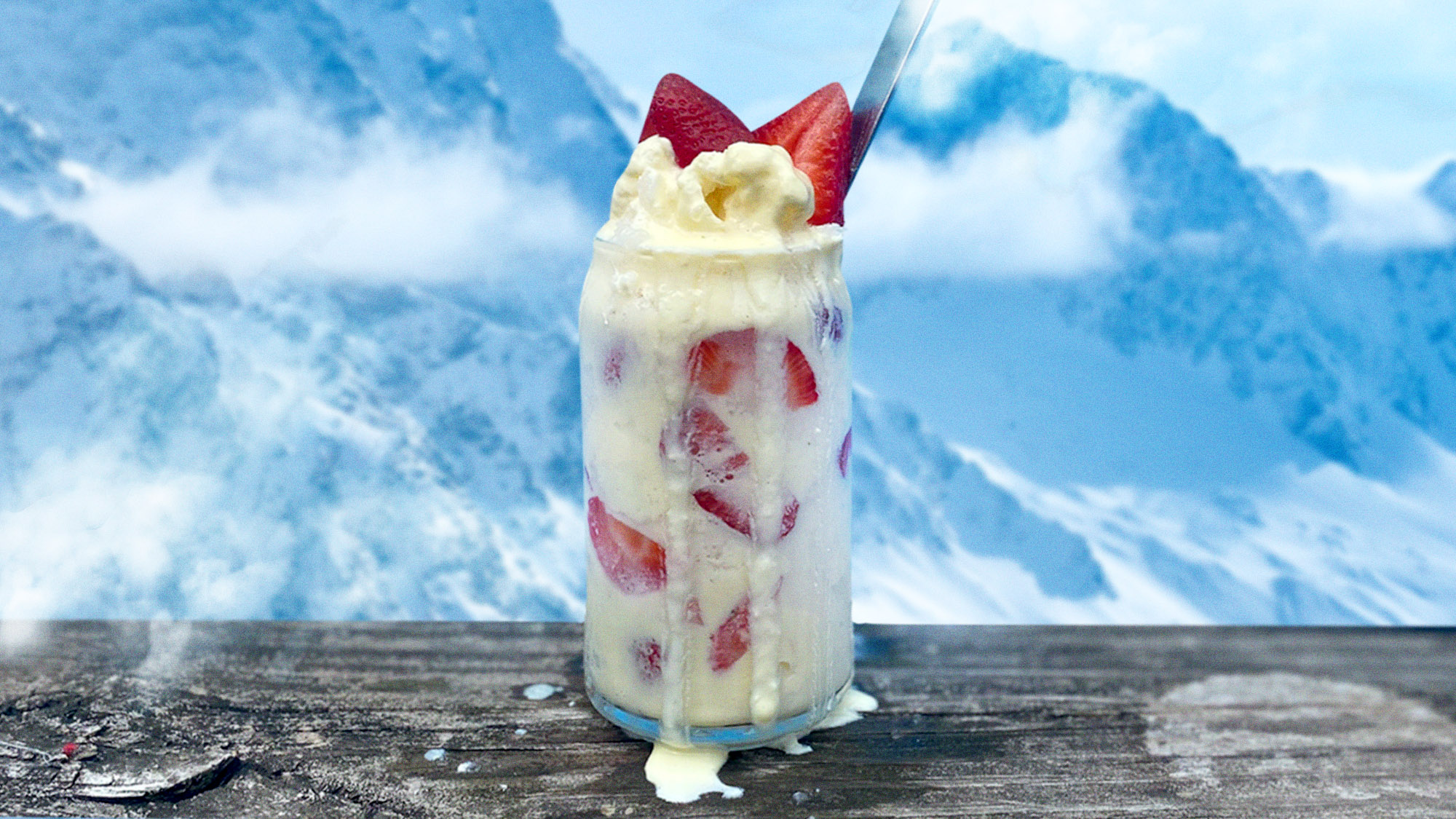Strawberry Buttermilk Snowballs Are A Blessed Mess
This summertime sweet has been keeping Baltimore cool for nearly 200 years
In five days, I'll be celebrating the fifth anniversary of the day I packed up my bags and left my hometown of Brooklyn, New York, for the beautiful, sunny shores of Baltimore, Maryland. And in eleven days, I'll be celebrating the fifth anniversary of the first time I tasted a Baltimore snowball. Though half a decade has passed, I still remember it vividly: It didn't contain the coarse, pebbly ice of snow cones, nor did it have the fluffy, snow-like texture of shaved ice. It was not slick and syrupy like an Italian ice, even though it was literally a cup of syrup-drenched ice. It had been pulverized into perfectly sized specks of "chewy ice," not too big to break your teeth and not too fine to melt right away. A Baltimore snowball is just right.
There are about two dozen flavors on the menu at any given snowball shop, but as a first-timer, I was advised to order the most Baltimore flavor of them all: egg custard. According to local lore, snowballs originated sometime in the early 19th century when wagons were used to transport massive blocks of ice from the cold, frigid North down to the hot, humid South; when those wagons passed through the city, local kids would charm the wagoneers into giving them ice shavings, and their mothers would whip up a cheap, simple egg custard to pour on top. As a documented pudding aficionado I was immediately on board with this concept, but when I got to the snowball shop, I learned that the egg custard is not actually custard: it's a yellow-tinted vanilla syrup that, like most other snowball syrup flavors, is purchased from a local company called Koldkiss. And it's delicious.
Though the deceptive name could have disappointed me, I came to love the egg custard snowball for exactly what it is. But I wondered when the dairy that usually defines an egg custard was dropped from the recipe, so I called upon two Baltimore snowball experts to help me out: culinary historian Kara Mae and cookbook author Rachel Rappaport. They theorized that there may never have been milk or cream in egg custard at all, and that these Industrial Revolution-era mothers may have been mixing eggs into molten sugar syrup not for flavor, but to remove impurities. Or, they might have added the word "egg" to the name so it wouldn't look like they weren't feeding their kids straight sugar water.
Since none of us own a time machine (yet), we'll probably never know for sure. But what we did realize is that we all know how to cook damn well, and there was no reason that we couldn't make our own milk-based egg custard and pour it over ice ourselves. If you don't like buttermilk, make this with whole milk or half-and-half. If you're not in the mood for strawberries, try this with blackberries, peaches, or any other summer fruit. And if you want the "authentic" Baltimore egg custard snowball experience, either pay us a visit (it's a great city!), or order yourself a bottle of syrup straight from the source.
Strawberry Buttermilk Snowballs
Makes 2
- 1 1/2 cups buttermilk, or 1 cup milk mixed with 1/2 cup sour cream
- 3 egg yolks
- 1/4 cup sugar, plus an additional 1/4 tsp.
- 1/2 tsp. pure vanilla extract
- Pinch salt
- 3/4 cup–1 cup sliced strawberries (don't worry about an exact measurement)
- 4 cups ice cubes
To make the custard
If using the microwave: Whisk together the buttermilk, egg yolks, and 1/4 cup sugar in a large microwave-safe bowl, then partially cover with plastic wrap, parchment paper, or an inverted plate and microwave for 2 minutes. Give the mixture a good whisk and cover the bowl again, remembering to leave a gap for steam to escape. Microwave for another 2 minutes and whisk again.
Keep repeating this process, microwaving in 45-second increments and then whisking, until the sauce is thick enough to coat the back of a spoon. (The exact amount of time will vary depending on your microwave, but in mine, it takes about 6 to 7 minutes to thicken.) Whisk in the vanilla and salt, then cover and refrigerate for at least 15 minutes to cool.
If cooking on the stove: Whisk the buttermilk, egg yolks, and 1/4 cup sugar in a medium saucepan; cook over medium-high heat while whisking constantly until mixture is thick enough to coat the back of a spoon—about 4 to 5 minutes. Remove from heat, whisk in the vanilla and salt, and transfer to a large measuring cup or container. Cover and refrigerate for at least 15 minutes to cool.
To make the strawberries
In a small bowl, gently toss the sliced strawberries with 1/4 tsp. sugar. Cover the bowl and let it sit at room temperature for at least 10 minutes to macerate. (If you'd like to make this ahead of time, you can just toss the strawberries and sugar in a container and refrigerate until you're ready to make snowballs.)
To make the snowballs
Put the 4 cups of ice cubes into a blender, press the "crush" button, and let that puppy go until the ice is as fine as can be without turning into snow.
Pour a little bit of custard into the bottom of two pint glasses with a spoonful of strawberries, then add about 2" of crushed ice to each glass. Add enough custard to saturate the ice, then add another scoop of strawberries and more ice. Repeat until the glasses are full, then serve immediately with a long-handled spoon and plenty of napkins.
